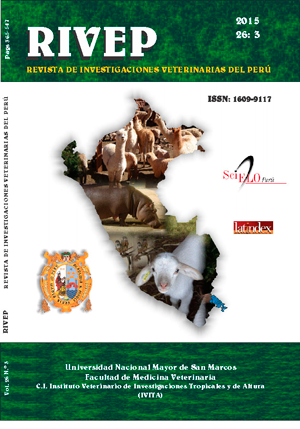Veterinary practice in domestic dogs as a risk factor for Toxocara canis In Lima, Peru
DOI:
https://doi.org/10.15381/rivep.v26i3.11166Keywords:
toxocariasis, T. canis, veterinarians, clinicsAbstract
The frequency of seropositives and risk of exposure to Toxocara canis in the personnel working in veterinary clinics in the city of Lima was determined. An exposed group with direct contact to dogs (n=135) and a non-exposed group of administrative staff (n=108) were evaluated. Sera samples were analyzed by ELISA test using excretion/ secretion antigens of L2 larvi of T. canis in dilutions of 1/200, 1/400, 1/800, 1/1600 and greater than 1/1600, searching for IgG antibodies. In the exposed group, 95.6, 58.5, 37.0, 23.7 y 9.6% resulted positive in the dilutions studied, respectively, and in the non-exposed group 97.2, 50.0, 32.4, 17.6 y 3.7% resulted positive respectively. No association was found between the proportion of positives and the two groups. It was concluded that the professional practice does not represent a risk factor for the occurrence of human infections by T. canis.Downloads
Downloads
Published
Issue
Section
License
Copyright (c) 2015 Lady Anacleto N., Néstor Falcón P., William Roldán G., Norma Noé M., Yrma Espinoza B.

This work is licensed under a Creative Commons Attribution-NonCommercial-ShareAlike 4.0 International License.
AUTHORS RETAIN THEIR RIGHTS:
a. Authors retain their trade mark rights and patent, and also on any process or procedure described in the article.
b. Authors retain their right to share, copy, distribute, perform and publicly communicate their article (eg, to place their article in an institutional repository or publish it in a book), with an acknowledgment of its initial publication in the Revista de Investigaciones Veterinarias del Perú (RIVEP).
c. Authors retain theirs right to make a subsequent publication of their work, to use the article or any part thereof (eg a compilation of his papers, lecture notes, thesis, or a book), always indicating the source of publication (the originator of the work, journal, volume, number and date).



